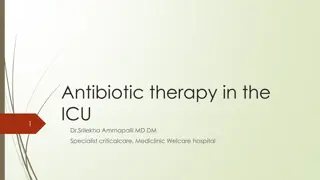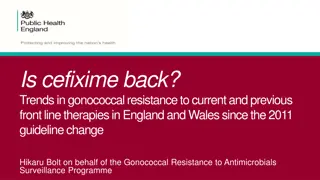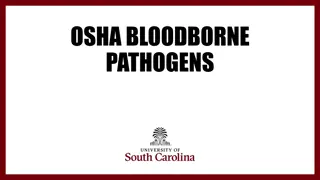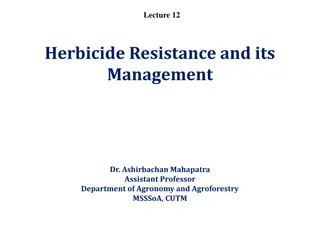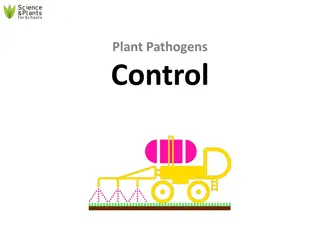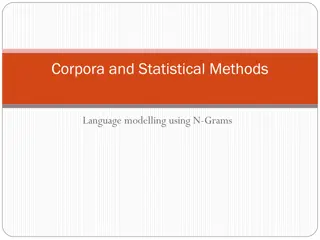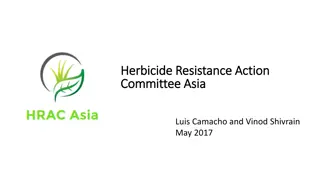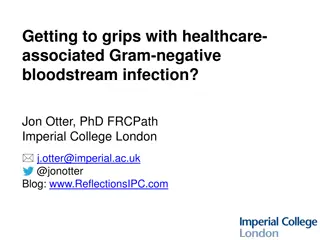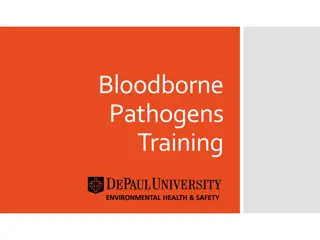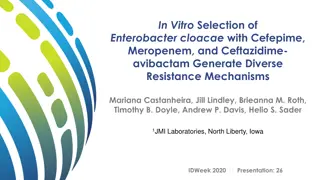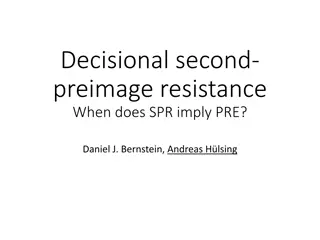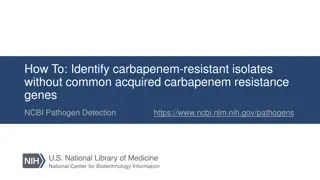Emerging Trends in Carbapenem Resistance Among Gram-Negative Pathogens
Antibiotic resistance poses a global healthcare crisis, with carbapenem-resistant organisms presenting a particular challenge. This study at UPMC aims to define the epidemiology of CROs, analyze antibiotic use trends, and evaluate patient outcomes. Through microbiology data analysis from 2000-2015, associations between carbapenem usage and CRO rates will be explored. The research objective is to enhance understanding of this critical issue and inform strategic interventions.
Download Presentation

Please find below an Image/Link to download the presentation.
The content on the website is provided AS IS for your information and personal use only. It may not be sold, licensed, or shared on other websites without obtaining consent from the author.If you encounter any issues during the download, it is possible that the publisher has removed the file from their server.
You are allowed to download the files provided on this website for personal or commercial use, subject to the condition that they are used lawfully. All files are the property of their respective owners.
The content on the website is provided AS IS for your information and personal use only. It may not be sold, licensed, or shared on other websites without obtaining consent from the author.
E N D
Presentation Transcript
EMERGING WAVES OF CARBAPENEM RESISTANCE AMONG GRAM-NEGATIVE PATHOGENS AT A TERTIARY CENTER Presenter: Julie Paronish Faculty Advisor: Nancy W. Glynn, PhD Internship Preceptor: Ryan K. Shields, PharmD, MS
Background Antibiotic resistance has emerged as a healthcare crisis around the world In the United States alone, more than $30 billion dollars a year are spent on treating drug-resistant infections Given the limited therapeutic options for treatment of antibiotic-resistant pathogens, patient morbidity and mortality are disproportionately high Carbapenems are considered one of the last lines of defense against drug-resistant bacteria; however, rates of carbapenem-resistant organisms (CROs) have increased
Background Despite recent global trends, the epidemiology of CROs at individual centers remains poorly defined So too are patient or hospital factors associated with the emergence of CROs At UPMC Presbyterian hospital, carbapenem resistance is now common across many Gram- negative pathogens Overall burden of CROs, and the pathogen-specific impact on patient outcomes are unknown
Objectives & Hypothesis Objectives Define the epidemiology of CROs at UPMC Identify associations between trends in antibiotic use and CROs Describe characteristics and outcomes of patients with CROs Hypotheses Carbapenem resistance has emerged over time across many pathogens Increased carbapenem usage is associated with increasing rates of CROs at UPMC Patient outcomes vary by pathogen, severity of illness, and underlying diseases
Methods Microbiology data extracted from 2000 2015 Data sources: MISYS and Sunquest Inpatient locations only UPMC Presbyterian Carbapenem resistance was defined by the 2016 CLSI interpretive criteria, and applied retrospectively throughout the study Unique patients were identified by pathogen for epidemiology analysis (e.g. patients may be re-included for each pathogen) For outcome analysis, unique patients were identified by the first CRO isolated (e.g. patients were not re-included) Social Security Death Index to determine time to death
Statistical Analysis Epidemiological trends in CROs and antibiotic daily defined doses were determined by linear regression Time series, cross-correlation regression analysis was used to compare trends in CROs as a function of antibiotic consumption Kaplan-meier graphs were used to plot survival over time, and compared by the log-rank test In univariate analysis to identify predictors of death, continuous and categorical variables were compared by student s t-test and chi-square, respectively In multivariate analysis, a logistic regression model was built with stepwise backward selection procedures using variables with a P-value <0.10 Using coefficients from the logistic regression model, a prediction equation was derived by fitting the data to an inverse probability model
Gram-negative pathogens at UPMC 97,747 isolates from 42,070 patients were identified n n Organism % CRO Organism % CRO A. baumannii 2,954 36.46% A. baumannii 2,954 36.46% C. freundii 2,209 2.72% C. freundii 2,209 2.72% E. coli 28,676 1.14% E. coli 28,676 1.14% E. aerogenes 3,230 5.91% E. aerogenes 3,230 5.91% E. cloacae 6,487 6.81% E. cloacae 6,487 6.81% K. oxytoca 3,370 2.05% K. oxytoca 3,370 2.05% K. pneumoniae 15,864 9.30% K. pneumoniae 15,864 9.30% M. morganii 1,199 4.25% M. morganii 1,199 4.25% P. mirabilis 6,372 2.57% P. mirabilis 6,372 2.57% P. aeruginosa 22,851 22.58% P. aeruginosa 22,851 22.58% S. marcescens 4,535 4.26% S. marcescens 4,535 4.26%
Targeted CROs (2000 2015) 84,597 isolates from 37,823 patients 8,864 isolates from 4,994 patients were defined as CRO A. baumannii E. coli Enterobacter K. pneumoniae P. aeruginosa S. marcescens 250 # of Unique Patients at UPMC 200 150 100 50 0 2000 2001 2002 2003 2004 2005 2006 2007 2008 2009 2010 2011 2012 2013 2014 2015
Rates of Carbapenem Resistance by Pathogen 70% A. baumannii E. coli Enterobacter K. pneumoniae P. aeruginosa S. marcescens 60% % Carbapenem Resistance 50% 40% 30% 20% 10% 0% 2000 2001 2002 2003 2004 2005 2006 2007 2008 2009 2010 2011 2012 2013 2014 2015
Incidence of Carbapenem Resistance Rate per 1,000 patient days Pathogen n 2000 2001 2002 2003 2004 2005 2006 2007 2008 2009 2010 2011 2012 2013 2014 2015 547 0.04 0.04 0.04 0.05 0.02 0.05 0.07 0.19 0.32 0.36 0.39 0.34 0.2 0.18 0.2 0.19 A. baumannii 372 0 0 0 0.02 0.03 0.04 0.05 0.05 0.08 0.07 0.07 0.1 0.14 0.2 0.11 0.12 E. coli 536 0.03 0.05 0.02 0.03 0.01 0.02 0.04 0.02 0.02 0.05 0.16 0.3 0.3 0.38 0.48 0.34 Enterobacter 650 0.01 0.01 0.02 0.05 0.06 0.06 0.07 0.14 0.24 0.26 0.38 0.43 0.52 0.33 0.43 0.43 K. pneumoniae 2267 0.74 0.74 0.7 0.64 0.53 0.61 0.68 0.81 0.82 0.88 0.83 0.96 0.95 1.03 1.11 1.09 P. aeruginosa 127 0.03 0.03 0.03 0.02 0.04 0.03 0 0.02 0.05 0.02 0.02 0.02 0.04 0.14 0.1 0.08 S. marcescens
Recurrence rates by pathogen 0.25 0.2 0.15 0.1 0.05 0 ACAT ECOL ENT KLPN PSAR SERM Recurrence-Same Pathogen Recurrence-Other Pathogen
Antibiotic daily defined doses (DDDs) 160 P-VALUE 0.0000 0.0001 0.0641 R-SQUARED 0.9242 0.7005 0.2240 140 Carbapenems Fluoroquinolones Piperacillin/tazobactam 120 100 80 60 40 20 0 2001 2002 2003 2004 2005 2006 2007 2008 2009 2010 2011 2012 2013 2014 2015 Trends for aminoglycosides and cephalosporins were not significant (data not shown)
Association between CROs and DDDs Cross-correlation regression analysis showed that increased carbapenem use and the emergence of CROs occurred simultaneously By pathogen . xcorr carba total, table lag(5) All CROs LAG R-squared -1 0 1 LAG CORR [Cross-correlation] ACAT -3 0.6106 -5 0.0669 ECOL 0 0.8868 -4 0.2757 -3 0.4608 ENT 0 0.8534 -2 0.5981 -1 0.7700 KLPN 0 0.8790 0 0.9070 1 0.8049 PSAR 0 0.8616 2 0.6390 3 0.4856 SERM 0 0.6258 4 0.3126 TOTAL 0 0.9070 5 0.1719
Patient characteristics Factor All Patients (n=4,994) Median Age, years (std dev) Male, no. (%) 57.8( 15.9) 2,811(56) ICU at time of culture, no. (%) 2,064(41) Solid Organ Transplant Recipient, no. (%) 1,297(26)
Kaplan-meier survival estimates By log rank test: ACAT was associated with a higher rate of 30- and 90- mortality compared to all other pathogens PSAR was associated with a lower rate of 30- and 90- mortality compared to ACAT and KLPN
Mortality Rate by Culture Source Respiratory 182 19 71 103 600 24 999 Urine 8 17 19 71 53 3 171 D. Wound 30 12 39 33 114 7 235 Blood 19 14 15 54 33 15 150 S. Wound 4 0 2 3 17 0 26 Other 0 0 0 0 2 0 2 ACAT (589) ECOL (232) ENT (487) KLPN (750) PSAR (2794) SERM (142) TOTAL 45.00% 40.00% 35.00% 30.00% 25.00% 20.00% 15.00% 10.00% 5.00% 0.00% Respiratory Urine D. Wound Blood 90 day Mortality Rate S. Wound Other Total 30 day Mortality Rate
Logistic Regression Factor Alive (n=4,022) Dead (n=972) P-value Male Age > 65 Residence in ICU SOT 2,237 (55.6%) 226 (5.6%) 1,410 (35.1%) 1,104 (27.4%) 574 (59.1%) 406 (41.8%) 654 (67.3%) 193 (19.9%) 167 (28.4%) 37 (15.9%) 91 (18.7%) 0.0900 <0.0001 <0.0001 0.0020 A.Baumannii E. coli 422 (10.5%) 195 (4.8%) <0.0001 0.1936 Enterobacter 396 (9.8%) 0.6921 Organism 162 (21.6%) K. Pneumoniae 588 (14.6%) 0.1204 483 (17.3%) Pseudomonas 2,311 (57.5%) <0.0001 32 (22.5%) S. marcescens 110 (2.7%) 0.4063 Respiratory Urine D. Wound Blood S. Wound 2,233 (55.5%) 661 (16.4%) 72 (18.1%) 288 (7.2%) 91 (2.3%) 614 (63.2%) 89 (9.2%) 143 (14.7%) 105 (10.8%) 19 (2.0%) <0.0001 <0.0001 <0.0001 0.0002 0.6419 Culture
Estimating mortality using prediction model Variable -coefficient Rationale Can use coefficients from logistic regression model to make predictions for individual patients Intercept Age Male ICU SOT -4.03225 0.020666 0.113142 1.290581 -0.30932 0.273369 -0.28304 -0.23665 0.073806 -0.19427 0.862593 0.514527 0.822352 1.20741 1.002972 Equation ACAT ECOL ENT KLPN PSAR RESP URINE DWOUN BLOOD SWOUN ??+?1?1+?2?2+..???? 1+??+?1?1+?2?2+..???? p= Organism Culture
Estimating mortality using prediction model Example 1 65 year old, non-transplant man in the ICU with A. baumanii in blood cultures Predicted mortality = 54.87% Example 2 45 year old, liver transplant female on a medical ward with K. pneumoniae in urine cultures Predicted mortality = 5.61% Example 3 79 year old, non-transplant man in the ICU with P. aeruginosa in respiratory cultures Predicted mortality = 41.88%
Conclusions CROs have emerged in waves over time at UPMC Antibiotic consumption does not appear to be associated with the epidemiology of CROs CROs are associated with high rates of mortality Identification of A. baumannii, residence in the ICU, and older age are important predictors of death Solid-organ transplant recipients, on the other hand, have lower rates of death following isolation of CROs Active surveillance and infection control strategies will be useful to identify and control the emergence of other CROs, respectively


